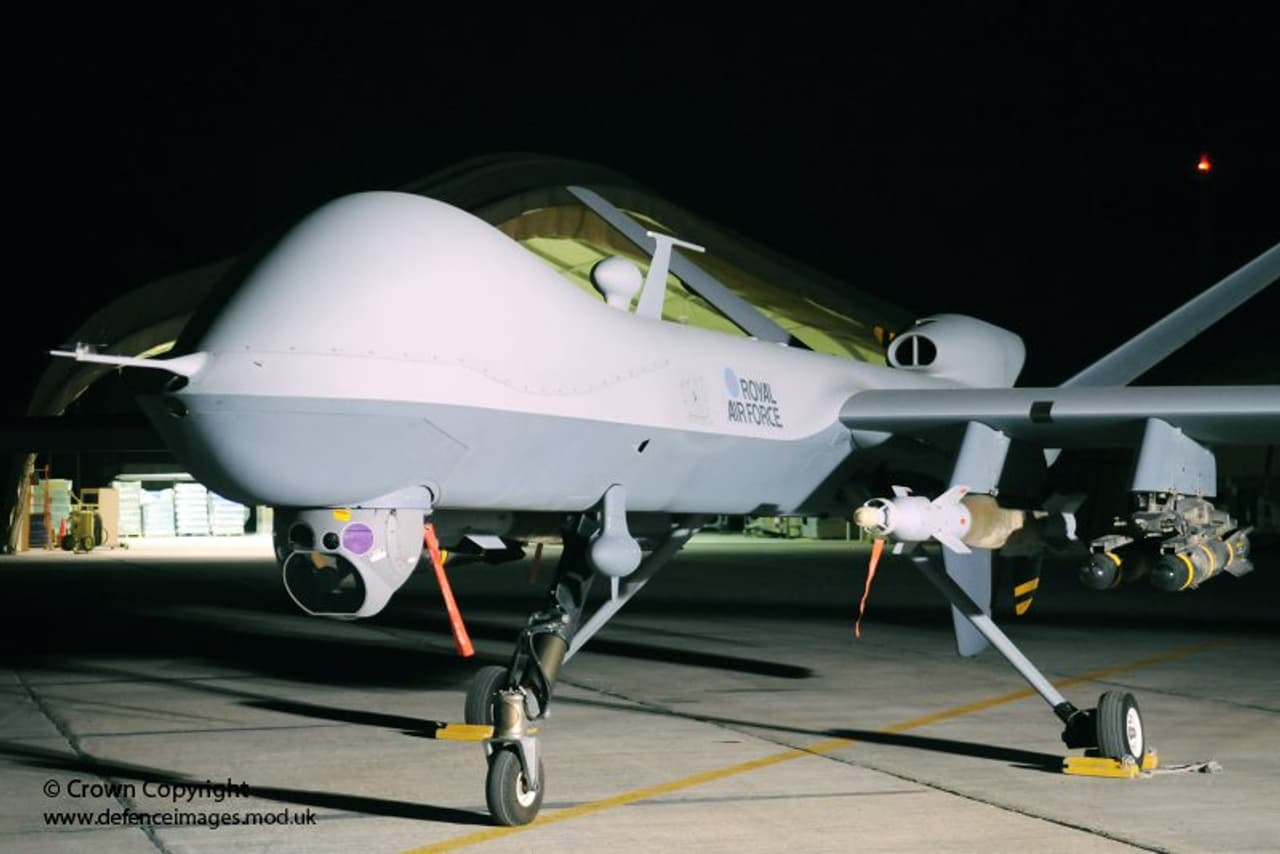
UK government spends £2bn on drones
British Reapers strike targets in Afghanistan from Kandahar airbase.
The British government has spent over £2bn on drones since 2007, according to a new report.
Shelling Out, by advocacy group Drone Wars UK, is the first complete assessment of UK government spending on unmanned aircraft.
It is built on publicly available data that is buried among mountains of government documents. Drone Wars UK trawled through the official records to compile the report.
It reveals the single biggest spend is on an unarmed surveillance drone that has yet to enter service – despite so far costing taxpayers £847m. The drone Watchkeeper was meant to be operational by June 2010. It is now running 30 months late.
The government renegotiated the contract when the manufacturer said it was going to miss its deadline, reducing the costs. Chris Cole, Drone Wars UK director, told the Bureau the original price tag was ‘just over £1bn.’
Homegrown UK drones do not have a good record. Watchkeeper is a replacement for Phoenix, also known as ‘the Bugger Off‘ because it frequently left on missions and never returned. The Open University uses this particular ‘dismal failure of a British-built drone‘ as an example of what not to do for its systems engineering students. Phoenix cost the taxpayer £345m and left service seven years early, in 2006.
| British drone fleet | Manufacturer | Quantity | Cost |
| Reaper armed strike drone | General Atomics (US) | 10 | £506m |
| Desert Hawk hand-launched surveillance drone | Lockheed Martin (US) | Over 111 | £42m |
| Hermes 450 surveillance drone | Elbit Systems (Israel) | 12 | £181m |
| Black Hornet palm-sized scout drone | Prox Dynamics (Norwegian) | Unknown | £20m |
| T-Hawk scout drone, fits in a backpack | Honeywell (US) | 12 | £3m |
| Watchkeeper surveillance drone, replacing Hermes but delayed until spring 2013 | Elbit Systems (Israel) and Thales UK | 54 | £847m |
Source: Drone Wars UK
The Ministry of Defence (MoD) has spent £872m on buying and flying drones over the past five years. More than £500m of this went on paying for ten deadly Reaper drones, the same aircaft used by the US to attack its enemies around the world. As yet British Reapers have only been used in Afghanistan, although it has emerged that British pilots flew US drones over Libya.
The UK’s drone fleet pales compared with the US. The Guardian reports the US military has 97 Reaper and 191 Predator drones. The Predator is an older and smaller version of the Reaper that carries fewer weapons.
All Britain’s drones are currently made by US, Israeli or Norwegian companies. The 12 Hermes surveillance drones used by the British Army in Afghanistan are owned by an Anglo-Israeli company and the MoD leases them on a ‘pay-by-flight’ basis.
The first strike by a British Reaper drone hit Afghanistan in May or June 2008, at least seven months after they entered UK military service. The RAF flies its Reapers from Kandahar airbase in Afghanistan. But most of the British operators fly the drones from Creech, a US base in the Nevada desert. Creech is also home to Reaper and Predator pilots from the US Air Force, Army and the CIA. Most of the 38,500 hours flown by British Reaper pilots have been intelligence gathering, reports the Daily Telegraph. In more than four years of operations UK drone pilots have launched missiles and bombs 319 times with four civilian casualties, adds the paper. The MoD is concerned about civilian casualties and the propaganda damage they may inflict. A senior RAF commander told the Telegraph: ‘We’re trying to get it into the guys’ heads that this is not compound no. 28, it’s 34 Acacia Drive – so you don’t hit it.’
The RAF’s Reapers
The government has spent £1.3bn on developing and testing new, British drones. This includes £17m spent developing Parc Aberporth, home to the West Wales UAV Centre where the Watchkeeper drone is tested, and £167m spent on the Mantis and Taranis projects.
Mantis is a prototype similar to the armed Reaper drone. But it is designed to be autonomous, operating with minimal human control. Taranis is a test drone for experimenting on combining autonomy and stealth technology with intercontinental range.
The British government has also spent £120m funding research by the arms industry and UK universities into future generations of drones. The report cautions this is a conservative figure as an accurate picture of government funding of UK universities could not be found.
The report is notably limited to government spending. UK major arms companies like BAE Systems, QinetiQ and Rolls Royce are also funding drone research and development. Drones are seen as the future of military flight, eventually replacing manned aircraft. A such, the level of government spending on drones is a ‘significant statement of intent,’ says Chris Cole, author of the report.
‘Despite a whole raft of legal and ethical concerns the government seems determined to expand their use,’ he says.
The government will continue spending big on drones and the UK will not be alone in that. Analysts predict countries will spend $86bn (£53.2m) on drones over the next 10 years as the world’s annual drone budget nearly doubles from $6.6bn to $11.4bn.
An MoD spokesman said: ‘All MoD procurement is subject to tough scrutiny and is dictated by delivering what our Armed Forces require. The main contribution of Remotely Piloted Air Systems in Afghanistan is surveillance and reconnaissance, providing vital intelligence to protect our troops.’


